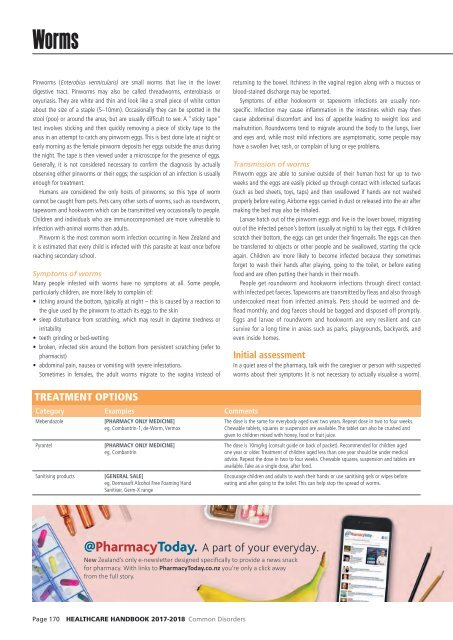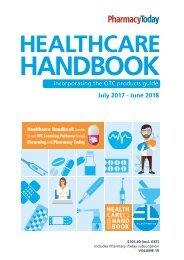2017 HCHB_digital
Create successful ePaper yourself
Turn your PDF publications into a flip-book with our unique Google optimized e-Paper software.
Worms<br />
Pinworms (Enterobius vermicularis) are small worms that live in the lower<br />
digestive tract. Pinworms may also be called threadworms, enterobiasis or<br />
oxyuriasis. They are white and thin and look like a small piece of white cotton<br />
about the size of a staple (5–10mm). Occasionally they can be spotted in the<br />
stool (poo) or around the anus, but are usually difficult to see. A "sticky tape"<br />
test involves sticking and then quickly removing a piece of sticky tape to the<br />
anus in an attempt to catch any pinworm eggs. This is best done late at night or<br />
early morning as the female pinworm deposits her eggs outside the anus during<br />
the night. The tape is then viewed under a microscope for the presence of eggs.<br />
Generally, it is not considered necessary to confirm the diagnosis by actually<br />
observing either pinworms or their eggs; the suspicion of an infection is usually<br />
enough for treatment.<br />
Humans are considered the only hosts of pinworms, so this type of worm<br />
cannot be caught from pets. Pets carry other sorts of worms, such as roundworm,<br />
tapeworm and hookworm which can be transmitted very occasionally to people.<br />
Children and individuals who are immunocompromised are more vulnerable to<br />
infection with animal worms than adults.<br />
Pinworm is the most common worm infection occurring in New Zealand and<br />
it is estimated that every child is infected with this parasite at least once before<br />
reaching secondary school.<br />
Symptoms of worms<br />
Many people infested with worms have no symptoms at all. Some people,<br />
particularly children, are more likely to complain of:<br />
• itching around the bottom, typically at night – this is caused by a reaction to<br />
the glue used by the pinworm to attach its eggs to the skin<br />
• sleep disturbance from scratching, which may result in daytime tiredness or<br />
irritability<br />
• teeth grinding or bed-wetting<br />
• broken, infected skin around the bottom from persistent scratching (refer to<br />
pharmacist)<br />
• abdominal pain, nausea or vomiting with severe infestations.<br />
Sometimes in females, the adult worms migrate to the vagina instead of<br />
returning to the bowel. Itchiness in the vaginal region along with a mucous or<br />
blood-stained discharge may be reported.<br />
Symptoms of either hookworm or tapeworm infections are usually nonspecific.<br />
Infection may cause inflammation in the intestines which may then<br />
cause abdominal discomfort and loss of appetite leading to weight loss and<br />
malnutrition. Roundworms tend to migrate around the body to the lungs, liver<br />
and eyes and, while most mild infections are asymptomatic, some people may<br />
have a swollen liver, rash, or complain of lung or eye problems.<br />
Transmission of worms<br />
Pinworm eggs are able to survive outside of their human host for up to two<br />
weeks and the eggs are easily picked up through contact with infected surfaces<br />
(such as bed sheets, toys, taps) and then swallowed if hands are not washed<br />
properly before eating. Airborne eggs carried in dust or released into the air after<br />
making the bed may also be inhaled.<br />
Larvae hatch out of the pinworm eggs and live in the lower bowel, migrating<br />
out of the infected person’s bottom (usually at night) to lay their eggs. If children<br />
scratch their bottom, the eggs can get under their fingernails. The eggs can then<br />
be transferred to objects or other people and be swallowed, starting the cycle<br />
again. Children are more likely to become infected because they sometimes<br />
forget to wash their hands after playing, going to the toilet, or before eating<br />
food and are often putting their hands in their mouth.<br />
People get roundworm and hookworm infections through direct contact<br />
with infected pet faeces. Tapeworms are transmitted by fleas and also through<br />
undercooked meat from infected animals. Pets should be wormed and deflead<br />
monthly, and dog faeces should be bagged and disposed off promptly.<br />
Eggs and larvae of roundworm and hookworm are very resilient and can<br />
survive for a long time in areas such as parks, playgrounds, backyards, and<br />
even inside homes.<br />
Initial assessment<br />
In a quiet area of the pharmacy, talk with the caregiver or person with suspected<br />
worms about their symptoms (it is not necessary to actually visualise a worm).<br />
TREATMENT OPTIONS<br />
Category Examples Comments<br />
Mebendazole<br />
Pyrantel<br />
Sanitising products<br />
[PHARMACY ONLY MEDICINE]<br />
eg, Combantrin-1, de-Worm, Vermox<br />
[PHARMACY ONLY MEDICINE]<br />
eg, Combantrin<br />
[GENERAL SALE]<br />
eg, Dermasoft Alcohol Free Foaming Hand<br />
Sanitiser, Germ-X range<br />
The dose is the same for everybody aged over two years. Repeat dose in two to four weeks.<br />
Chewable tablets, squares or suspension are available. The tablet can also be crushed and<br />
given to children mixed with honey, food or fruit juice.<br />
The dose is 10mg/kg (consult guide on back of packet). Recommended for children aged<br />
one year or older. Treatment of children aged less than one year should be under medical<br />
advice. Repeat the dose in two to four weeks. Chewable squares, suspension and tablets are<br />
available. Take as a single dose, after food.<br />
Encourage children and adults to wash their hands or use sanitising gels or wipes before<br />
eating and after going to the toilet. This can help stop the spread of worms.<br />
@PharmacyToday. A part of your everyday.<br />
New Zealand’s only e-newsletter designed specifically to provide a news snack<br />
for pharmacy. With links to PharmacyToday.co.nz you’re only a click away<br />
from the full story.<br />
Page 170 HEALTHCARE HANDBOOK <strong>2017</strong>-2018 Common Disorders



